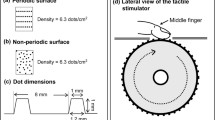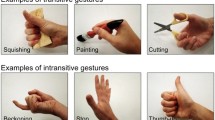Abstract
Introduction
The cerebral and cerebellar network involved in a bimanual object recognition was studied in blood oxygenation dependent level functional magnetic resonance imaging (fMRI).
Methods
Nine healthy right-handed volunteers were scanned (1) while performing bilateral finger movements (nondiscrimination motor task), and (2) while performing a bimanual tactile–tactile matching discrimination task using small chess pieces (tactile discrimination task).
Results
Extensive activations were specifically observed in the parietal (SII, superior lateral lobule), insular, prefrontal, cingulate and neocerebellar cortices (HVIII), with a left predominance in motor areas, during the tactile discrimination task in contrast to the findings during the nondiscrimination motor task.
Conclusion
Bimanual tactile–tactile matching discrimination recruits multiple sensorimotor and associative cerebral and neocerebellar networks (including the cerebellar second homunculus, HVIII), comparable to the neural circuits involved in unimanual tactile object recognition.



Similar content being viewed by others
References
Habas C, Axelrad H, Nguyen TH, Cabanis EA (2004) Specific neocerebellar activation during out-of-phase bimanual movements. Neuroreport 15:595–599
Habas C, Cabanis EA (2006) Cortical areas functionally linked with the cerebellar second homunculus during out-of-phase bimanual movements. Neuroradiology 48:273–279
Habas C, Axelrad H, Cabanis EA (2004) The cerebellar second homunculus remains silent during passive bimanual movements. Neuroreport 15:1571–1574
Reed CL, Shoham S, Halgren E (2004) Neural substrates of tactile object recognition: an fMRI study. Hum Brain Mapp 21:236–246
Roland PE (1976) Astereognosis. Tactile discrimination after localized hemispheric lesions in man. Arch Neurol 33:543–550
Roland PE (1985) Somatosensory detection in man. Exp Brain Res Suppl 10:93–110
Roland PE (1987) Somatosensory detection in patients with circumscribed lesions of the brain. Exp Brain Res 66:303–317
Roland PE (1987) Somatosensory detection of microgeometry, macrogeometry and kinesthesia after localized lesions of the cerebral hemispheres in man. Brain Res 434:43–94
Pause M, Kunesch E, Binkofski F, Freund HJ (1989) Sensorimotor disturbances in patients with lesions of the parietal cortex. Brain 112:1599–1625
Seitz RJ, Roland PE, Bohm C, Greitz T, Stone-Elander S (1991) Somatosensory discrimination of shape: tactile exploration and cerebral activation. Eur J Neurosci 3:481–492
Deibert E, Kraut M, Kremen S, Hart J Jr (1999) Neural pathways in tactile object recognition. Neurology 52:1413–1417
Jäncke L, Kleinschmidt A, Mirzazade S, Shah NJ, Freund HJ (2001) The role of inferior parietal cortex in linking the tactile perception and manual construction of object shapes. Cerebral Cortex 11:114–121
Reed CL, Klatzky RL, Halgren E (2005) What vs. where in touch: an fMRI study. Neuroimage 25:718–726
Van Boven RW, Ingeholm JE, Beauchamp MS, Bikle PC, Ungerleider LG (2005) Tactile form and location processing in the human brain. Proc Natl Acad Sci USA 102:12601–12605
Kaas AL, van Mier H, Goebel R (2006) The neural correlates of human working memory for haptically explored object orientations. Cerebral Cortex. DOI 10.1093/cercor/bhl074
Liu Y, Pu Y, Gao JH, Parsons LM, Xiong J, Liotti M, Bower JM, Fo PT (2000) The human red nucleus and lateral cerebellum in supporting roles for sensory information processing. Hum Brain Mapp 10:147–159
Jueptner M, Jenkins IH, Brooks DJ, Frackowiak RSJ, Passingham RE (1996) The sensory guidance of movements: a comparison of the cerebellum and basal ganglia. Exp Brain Res 112:462–474
Seidler RD, Noll DC, Chintalapati P (2006) Bilateral basal ganglia activation associated with sensorimotor adaptation. Exp Brain Res 175:544–555
Ito M (1982) The cerebellum and neural control. Raven Press, New York
Xu D, Liu T, Ashe J, Bushara KO (2006) Role of the olivo-cerebellar system in timing. J Neurosci 26:5990–5995
Massion J (1967) The mammalian red nucleus. Physiol Rev 47:383–436
Harada T, Saito DN, Kashikura K-I, Sato T, Yonekura Y, Honda M, Sadato N (2004) Asymmetrical neural substrates of tactile discrimination in humans: a functional magnetic resonance imaging study. J Neurosci 24:7524–7530
Lederman SJ, Klatzky RL (1987) Hand movements: a window into haptic object recognition. Cogn Psychol 19:342–368
Bohlhalter S, Fretz C, Weder B (2002) Hierarchical versus parallel processing in tactile object recognition. A behavioral-neuroanatomical study of aperceptive tactile agnosia. Brain 125:2537–2548
Valenza N, Ptak R, Zimine I, Badan M, Lazeyras F, Schnider A (2001) Dissociated active and passive tactile shape recognition: a case study of pure tactile apraxia. Brain 124:2287–2298
O’Sullivan BT, Roland PE, Kawashima R (1994) A PET study of somatosensory discrimination in man. Microgeometry versus macrogeometry. Eur J Neurosci 6:137–148
Hinkley LB, Krubitzer LA, Nagarajan SS, Disbrow EA (2006) Sensorimotor integration in S2, PV, and the parietal rostroventral areas of the human sylvian fissure. J Neurophysiol 97:1288–1297
Moore CI, Crosier E, Greve DN, Savoy R, Merzenich MM, Dale AM (2002) Cortical correlates of vibrotactile detection in humans. Cognitive Neuroscience Society, San Francisco
Stoeckel MC, Weder B, Binkofski F, Choi HJ, Amunts K, Pieperhoff P, Shah NJ, Seitz RJ (2004) Left and right superior parietal lobule in tactile object discrimination. Eur J Neurosci 19:1067–1072
Malach R, Reppas JB, Benson RR, Kwong KK, Jiang H, Kennedy WA et al (1995) Object-related activity revealed by functional brain imaging in human occipital cortex. Proc Natl Acad Sci USA 92:8135–8139
Peltier S, Stilla R, Mariola E, LaConte S, Hu X, Satthian K (2007) Activity and effective connectivity of parietal and occipital cortical regions during haptic shape perception. Neuropsychologia 45:476–483
Stoeckel MC, Weder B, Binkofski F, Buccino G, Shah NJ, Seitz RJ (2003) A fronto-parietal circuit for tactile object discrimination: an event-related fMRI study. Neuroimage 19:1103–1114
Mutschler I, Schulze-Bonhage A, Glauche V, Demandt E, Speck O, Ball T (2007) A rapid sound-action association effect in human insular cortex. Plos One 2:e259
Bonda E, Petrides M, Evans A (1996) Neural systems for tactual memories. J Neurophysiol 75:1730–1737
Carter CS, Braver TS, Barch DM, Botvinick MM, Noll D, Cohen JD (1998) Anterior cingulate cortex, error detection, and the online monitoring of performance. Science 280:747–749
Seeley WW, Menon V, Schatzberg AF, Keller J, Glover GH, Kenna H, Reiss AL, Greicius MD (2007) Dissociable intrinsic connectivity networks for salience processing and executive control. J Neurosci 27:2349–2356
Schmahmann JD, Pandya DN (1997) The cerebrocerebellar system. Int Rev Neurobiol 41:31–60
Middleton FA, Strick PL (2000) Basal ganglia and cerebellar loops: motor active and cognitive circuits. Brain Res Rev 31:236–250
Ito M (1993) Movement and thought: identical central mechanisms by the cerebellum. Trends Neurosci 16:447–450
Conflict of interest statement
We declare that we have no conflict of interest.
Author information
Authors and Affiliations
Corresponding author
Rights and permissions
About this article
Cite this article
Habas, C., Cabanis, E.A. The neural network involved in a bimanual tactile–tactile matching discrimination task: a functional imaging study at 3 T. Neuroradiology 49, 681–688 (2007). https://doi.org/10.1007/s00234-007-0239-8
Received:
Accepted:
Published:
Issue Date:
DOI: https://doi.org/10.1007/s00234-007-0239-8




